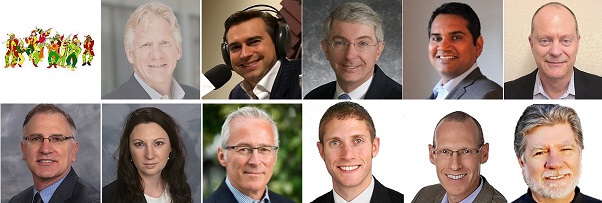 A lot has happened this year in the Health IT world. I found 11 pipers to pipe about what stood out to them. Here are their favorite newest health IT thing or happening of 2015.
A lot has happened this year in the Health IT world. I found 11 pipers to pipe about what stood out to them. Here are their favorite newest health IT thing or happening of 2015.
Dr. Nick van Terheyden, CMIO – Dell Healthcare
I’m going to go with genomics as the big Health IT advance that I am most excited about. Genomics has breached the sub $1000 cost to fully sequence a human genome and in less than 24 hours. This opens the door to incredible insights into the human body and our genetic make-up – not just our make-up but also our biome. As we start to capture and integrate this data into the existing medical knowledge expect to see big leaps in our understanding of the underlying causes of disease changing our approach to diagnosis and treatments of disease and as we learn more changing our approach to treating disease to preventing disease before it even occurs. Follow @drnic1 and @DellHealth.
Justin Barnes, Corporate/ Board Advisor and host of This Just In radio show
The passage of MACRA: H.R.2 – Medicare Access and CHIP Reauthorization Act of 2015: The passage of this law transforms our nation’s healthcare system and finally begins to position healthcare in America strategically towards quality and outcomes-based payments rather than volume-based payments. This is a direction that should serve patients and taxpayers much better than the antiquated fee-for-service model while increasing the “accountability” in healthcare at every level. This shift towards fee-for-value and alternative payment models may not be perfect to start with but we will perfect over time as all key stakeholders work together to create the highest quality and most sustainable healthcare system in the world. Here is more info on MACRA. Follow @HITAdvisor.
Lee Barrett – Executive Director – EHNAC
My favorite health IT trend was the cooperation I saw across the industry. To me, 2015 was the year of alliances, partnerships and collaborations. EHNAC’s strong partnerships with WEDI, DirectTrust, MGMA, HATA, and other provider- and vendor-facing member organizations demonstrated the commitment the healthcare industry has in building stakeholder trust and working closely together. In addition, the health IT industry’s collaboration with the ONC to implement their Roadmap and achieve full interoperability is a great example of the federal and private sectors joining forces to achieve an important common goal. It’s encouraging that so many healthcare stakeholders have continued to work together to achieve these goals, objectives and participate in a joint vision of the future. Follow @EHNAC.
Sasanka “SY” Yella. CEO – WhiteSpace Health Inc.
As we look back on 2015, we witnessed healthcare practices embracing technology trends like cloud and mobile solutions. However, we feel the most exciting emerging activities in the healthcare space involve advances in data analytics using machine learning and natural language processing. For the first time, small- to mid-sized physician practices can utilize business intelligence services to mine actionable insights from mounds of unstructured data collected in the form of EMR, survey and social media data at affordable subscription rates. These growing trends are leveling the technology playing fields and are allowing these smaller physician practices to compete and remain independent at very affordable rates. Learn more.
Jim Beagle, President and CEO – BridgeHead Software
The challenge of what to do with obsolete legacy applications certainly isn’t a new problem – it’s one that has plagued hospitals for years. But from what we saw in 2015, hospitals are finally drawing a line in the sand and are addressing this issue head-on. The costs associated with storing and accessing the non-standard data within hundreds of obsolete applications and systems can cost a large hospital system millions of dollars annually. In the past few months, we’ve seen a growing trend of hospital executives finally taking action toward resolving this issue, by working to migrate this data away from legacy applications and into a single data repository. That’s a trend that’s not only going to provide clinicians with better access to the patient data they need, when they need it, but it’s also going to reduce the cost of care in this country. Follow @BridgeHeadHDM.
Bennett Lauber, Chief Experience Officer – The Usability People
My Favorite Health IT thing was meeting Zubin Damania (aka @ZdoggMD) at the NextIT summit in Philadelphia after seeing his talk that included a live performance of “An EHR State of Mind.” Follow @UsabilityPeople and @uuAbility.
Crystal Ewing, Senior Business Analyst-Product – ZirMed
In 2015, healthcare finally achieved a real answer to claims denials and appeals management. Historically, for each denied claim staff spend, 4 minutes identifying the denial and routing it appropriately, + 10 minutes gathering information, + 30 minutes compiling and filling out appeal letter and materials, + 5 minutes just documenting all their activity related to the denial, and visit/log in to the associated payer’s website for 25 percent of denials. That is unacceptable and also unnecessary. 2015 witnessed the future of sustainably driving down denials and automating the most time-consuming aspects of the appeals process. Follow @ZirMed.
Terry Edwards, President and CEO – PerfectServe
In 2015, we’ve seen the rise of two trends, wearables and the Internet of Things. Right now, we are beginning to use consumer wearables to take health and fitness tracking into our own hands and as these wearables become more sophisticated (e.g., tracking body temperature, heart rate, oxygen levels, and other key metrics), we’ll need to find easier ways for health practitioners to harness this enormous amount of patient data. IoT helps make this possible by sharing data via the cloud, and triggering processes – like scheduling a visit to test for diabetes, or adjusting a prescription for cholesterol. The potential for these to not only improve patients’ health but to also drive technology in 2016, is why both are on my list of favorites. Follow @PerfectServeCEO and @PerfectServe.
Matt Fisher, Healthcare Lawyer – Mirick, O’Connell, DeMallie & Lougee, LLP
One of my favorite health IT happenings from 2015 was the increased focus on HIPAA and calls for better understanding. I saw many discussions of wearables, mHealth and other developments, but oftentimes the discussion then came around to HIPAA. While the discussion may not always have been accurate, the attention and focus on HIPAA to me is a positive. This means that many people are considering it and, if that keeps occurring, better awareness of what HIPAA does and how it really works are hopefully bound to follow. Once more people actually appreciate what HIPAA does, then maybe it will not be seen and used as a barrier quite so much. At the end of the day, HIPAA is meant to promote privacy and security while allowing health information to be used and disclosed. Follow him @Matt_R_Fisher.
Morris Panner, CEO – DICOM Grid
2015 should be known as the year when medical imaging moved to the cloud. Two factors drove this change. First, CMS’ bundled payment proposal requires health systems to focus on cost and quality. That means avoiding duplicative imaging and ensuring that providers have an easy way to share and view imaging. Second, as patients demand the best possible care and take more control of their care, healthcare providers have to make it easy for patients and referring physicians to send imaging for purposes of second opinions and collaborative care. The cloud uniquely enables both of these important imaging trends for providers, patients and payers. Follow them on Twitter @DICOMGrid.
Jim Tate, President EMR Advocate and Partner Answers Media Company
The transition from “pay for service” to “pay for value” healthcare reimbursement is a holiday gift that will keep on giving for years to come. Follow him on Twitter @jimtate.

Happy Holidays from all of us at Answers Media Company.
